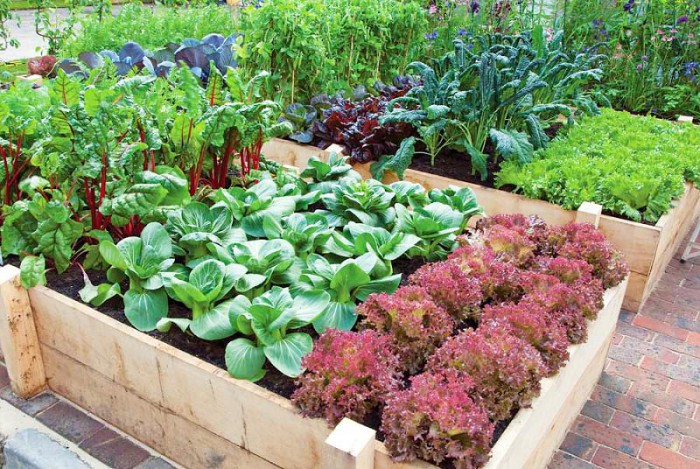With just a few secrets and some free time, you’ll have a wonderfully bountiful output this year whether you’re a first-time vegetable gardener or have twenty years of experience. We all can agree that there is nothing better than a monumental harvest at the end of the season, so follow these tips to make sure your garden is as productive as possible!
Table of Contents
Start Intensive Planting Beds
The surest way to increase the yield from a vegetable garden is to reduce the space between plants. The idea is to plant wide bands, thus reducing the amount of ground devoted to paths.
To start an intensive garden, make a bed of any length, but limit its width to 3 to 4 feet across so you can reach the center of the bed from either side. Although it’s not necessary to box in the bed, this is a good idea. When you enclose a bed with vertical boards, it’s not only neater, but the soil won’t collapse onto the paths. It also will be much easier for you to install row covers or erect supports for vertical growing.
Go Vertical
{You’ll find that some vegetables grow better with support. They do well on trellises, fences, and other structures. By growing up instead of out, your garden will produce more per square foot. Vegetable plants grown on a support also tend to suffer fewer disease problems.}
Some vegetables are just naturally climbing plants – meaning they’ll grow up rather than out if given the chance. This habit can actually be quite beneficial for home gardeners in a number of ways. For one, you’ll be able to get more veggies per square footage since they’re growing vertically.
Additionally, these supported plants are often less susceptible to disease compared to their ground-bound counterparts. So if you’re looking to get the most out of your vegetable garden, consider giving some of your crops a little boost up!
Tomatoes. Choose indeterminate varieties, which continue to grow and produce over a long period, often until frost. Grow tomatoes in wire cages or support them by tying them to 7-foot-tall wood stakes driven 2 feet into the ground.
Cage-grown tomatoes require minimal attention, but are more prone to fungal diseases. Tomatoes grown on stakes benefit from being pruned to a single stem; this means constantly pinching out new branches that arise in the crotch between the main stem and a leaf.
Pole beans are a type of bean that takes a little longer to mature than other bush beans, but they provide a longer harvest period. You can grow pole beans by training them to climb tall wooden poles or by creating a tepee out of sturdy bamboo.
Cucumbers are another type of vine that does well when grown on fences and trellises. Cucumbers that are grown vertically tend to be straighter and more uniform in shape than those that are grown on the ground.
Extend the Season
The best way to maximize your chances of having a successful crop is by succession planting. This means that you would plant your seeds at different intervals rather than all at once. This ensures that you have a steady supply of your crop over a period of time, rather than one big harvest all at once.
For example, instead of planting 40 corn seeds at once, you could plant 10 corn seeds a week over a four-week period. This will give you corn for a month instead of all at once.
Another example is to plant bush beans every two weeks to ensure a continuing supply. If you want to have three crops, plant one-third of the bed every two weeks. Other crops that benefit from this type of succession planting include corn, carrots, radishes, and heading lettuce.
Succession planting is a great way to make sure you have a constant supply of fresh produce!
Replace Spent Plants
The second type of succession planting is a little more complicated and requires more planning than the first. This method means that once a crop is done producing, you pull it out and replace it with something else.
For example, after your peas are finished for the season, you would remove the vines and plant cucumbers in their place. The key to making this system work is to have a new batch of seeds or seedlings ready to go as soon as the first crop is done. This system is most successful when you are starting with vegetables that grow well in cooler weather but don’t tolerate the heat of summer as well.
Start Interplanting
This gardening technique is all about maximizing the space in your garden by planting vegetables that have different harvest times next to each other.
This way, you can make use of the entire area of your garden and get multiple harvests throughout the season. For example, if you plant carrots and radishes together, you can harvest the radishes in about 30 days while the carrots are still growing.
This way, you’re not waiting around for one crop to finish before starting to harvest another. Another option is to combine a vertical vegetable (like tomatoes) with a low-growing crop (like melons).
Here are some interplanting combinations that work well:
- Growing sprawling melons and squash under stake-grown tomatoes.
- Surrounding corn with lettuce or peas with radishes.






![Is Tokyo Ghoul on Netflix? [How to Watch Online]](https://avctv.com/wp-content/uploads/2022/08/AAAABct1DaUzhEt4JeJFeDrmaE_4CGAu39fBN6poMx10hAlWlMRjkkAw84hjmuujWTy2wFC7_Pjnujec-_PqT1GCnnMFMJ15S04baJn1b0WvvbG6hrSNb31_GS4--120x86.jpg)





